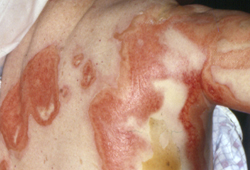History and exam
Key diagnostic factors
common
presence of risk factors
Key risk factors include anticonvulsant use and the use of certain other medicines, including recent antibiotics; recent infection; conditions such as systemic lupus erythematosus and AIDS; radiotherapy; smallpox vaccination; and human leukocyte antigen type and Chinese or Japanese ethnicity.
rash
A sudden rash or a rash that develops after a new medicine is started. There is a wide variation of lesion type and skin involvement. Common sites for initial rash include the upper torso, proximal limbs, and face.[63] Lesions spread from these sites to involve the rest of the trunk and distal limbs; involvement of the palms of the hands and soles of the feet is often prominent.[20][63]
mucosal involvement
Erosions or ulceration of the eyes, lips, mouth, pharynx, oesophagus, gastrointestinal tract, kidneys, liver, anus, genital area, or urethra.[63]
Nikolsky's sign
Epidermal layer easily sloughs off when pressure is applied to the affected area.[63]
uncommon
blisters
Blisters or macules and flat atypical target lesions, diffuse erythema.[63][Figure caption and citation for the preceding image starts]: Stevens-Johnson syndrome: targetoid lesions and epidermal lossFrom the personal collection of Dr A. Kowal-Vern [Citation ends].
Risk factors
strong
patients with active cancer
Patients with active cancer are associated with an increased risk of SJS/TEN.[6] One retrospective cohort study of patients with active cancer reported incidence rates of 7.2 and 17.9 per 100,000 patient-years for confirmed and confirmed plus possible cases of SJS/TEN, respectively.[8] This may be due to an immune response to cancer treatment. The mechanism may be reaction to a drug in a patient with a genetic susceptibility to the medication.
anticonvulsant medicines
The most common anticonvulsants precipitating SJS and TEN are carbamazepine, phenobarbital, phenytoin, lamotrigine, and valproic acid.[25][26] SJS and TEN usually develop in individuals who have started taking the medicine for 1-14 days as a new drug; if drugs are used for months or years, the risk for developing SJS and TEN usually occurs in the first 2 months of treatment.[24][25] The index day for developing SJS and TEN is less than a month after starting medication (15 days for carbamazepine, 24 days for phenytoin, 17 days for phenobarbital).[24] There may also be genetic factors that predispose these people to have a reaction to the medicine.
recent infection
Mycoplasma pneumoniae has been associated with the development of SJS with <10% total body surface area involvement. Viral infections that have precipitated SJS and erythema multiforme major include: herpes, Epstein-Barr virus, and cytomegalovirus.[20] They can present as ear, nose, and throat infections or with systemic symptoms.[19]
recent antibiotic use
The need to treat infection exposes a patient to possible adverse drug reactions with many antibiotics, especially those containing a sulfa derivative. The greatest risk is posed by the use of trimethoprim/sulfamethoxazole and other sulfonamide antibiotics, as well as aminopenicillins, quinolones, and cephalosporins.[2][17][25]
other medicines
Other medicines that may put the patient at risk are: antifungals, antivirals (e.g., telaprevir, aciclovir), antiretrovirals (e.g., nevirapine, abacavir), anthelmintics, analgesics (e.g., paracetamol), non-steroidal anti-inflammatory drugs, selective COX-2 inhibitors, antimalarials, corticosteroids, azathioprine, trimethoprim/sulfamethoxazole, sulfasalazine, allopurinol, tranexamic acid, psychotropic agents, chlormezanone, anticancer drugs (e.g., bendamustine, busulfan, chlorambucil) and targeted therapies (e.g. rituximab, imatinib, vemurafenib), and retinoids.[10][15][25][27][28][29][30][31][32][33][35][36][37][38][39]
systemic lupus erythematosus
Seen most frequently with SJS, SJS/TEN overlap, and TEN; not with erythema multiforme major.[20] Probable immune interaction with the medicines used to treat systemic lupus erythematosus (SLE), such as corticosteroids and isoniazid.[25] The mechanism is most likely to be the drug, but the individual may be genetically susceptible to a reaction to the medicine. It is sometimes difficult to determine if the sheet-like epidermal necrosis is due to SLE or SJS/TEN.[50]
HIV-positive
radiotherapy
Seen most frequently in oncological patients with recent anticonvulsant medicine during cranial irradiation.[51] Amifostine, which is used to protect normal tissues during irradiation and chemotherapy, has also been associated with SJS and TEN.[52] Patients are immunocompromised from their chemotherapy and the disease process.
human leukocyte antigen and genetic predisposition
Pharmacogenomic studies indicate that ethnicity and human leukocyte antigen (HLA) types may predispose patients to adverse drug reactions.[11][12][13][14][15] HLA-B*1502 allele has a strong association with carbamazepine-induced SJS and TEN in the Han Chinese population; the US Food and Drug Administration recommends testing all Asian people prior to prescribing this medication.[12] HLA-A*0206 and HLA-B*4403 are associated with cold-medicine-related SJS and TEN.[15] HLA-A*3101 has a strong association with SJS and TEN ocular and other complications regardless of ethnicity.[11] All individuals with HLA-B*5801 are at risk for allopurinol-induced SJS/TENS.[16]
Presence of HLA-B*1502, HLA-C*0602, or HLA-C*0801 alleles has been associated with trimethoprim/sulfamethoxazole-induced SJS/TEN.[2][17] The FDA recommends that patients are screened for the HLA-B*5701 allele before starting abacavir for HIV infection.[18]
weak
bone marrow transplantation
In this context, SJS needs to be differentiated from possible acute graft-versus-host disease (GVHD).[19] Both conditions start out as a rash. However, in GVHD the skin does not slough off as readily as it does in SJS or TEN. SJS or TEN may result from a drug reaction, whereas GVHD develops after the host lymphocytes attack the donated organ or tissue. It is occasionally difficult to distinguish between GVHD and TEN, particularly because both may occur in a patient in the same timespan.[53] In these cases, SJS/TEN is most frequently drug-related. Mortality is high.
Use of this content is subject to our disclaimer